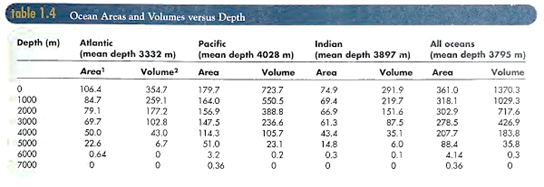The Distribution of Land and Water. The Oceans
To understand the present distribution of land and water on the Earth, consider the Earth when it is viewed from the north (fig. 1.18a) and from the south (fig. 1.18b). About 70% of the Earth’s landmasses are in the Northern Hemisphere, and most of this land lies in the middle latitudes. The Southern Hemisphere is the water hemisphere, with its land located mostly in the tropical latitudes and in the polar region. The details of this land-water-latitude distribution are presented in figure 1.19.

Fig. 1.18. Continents and oceans are not distributed uniformly over the Earth. The Northern Hemisphere (a) contains most of the land; the Southern Hemisphere (b) is mainly water

Fig. 1.19. Distribution of land and ocean by latitude. In the Northern Hemisphere, middle-latitude areas of land and ocean are nearly equal. Land is almost absent at the same latitudes in the Southern Hemisphere. The areas are calculated on the basis of 5° latitude intervals
The Oceans. Oceanographers view the world ocean as three fingers—the Atlantic, Pacific, and Indian Oceans—stretching up from a common source around Antarctica. The Arctic Ocean is considered an extension of the North Atlantic, and the circumpolar Antarctic Ocean may be considered as the Southern Ocean at latitudes greater than 50°S, or it may be divided along chosen lines of longitude to become the southern portions of the Atlantic, Pacific, and Indian Oceans (fig. 1.20).

Fig. 1.20. The world’s three major oceans, the Atlantic, Pacific, and Indian, extend northward from Antarctica. The Arctic Ocean is considered part of the Atlantic Ocean
Each of these three oceans has its own characteristic surface area, volume, and mean depth. The Pacific Ocean has more surface area, a larger volume, and a greater mean depth than either the Atlantic Ocean or the Indian Ocean. The Atlantic Ocean is the shallowest ocean and has the greatest number of shallow adjacent seas, such as the Arctic Ocean, Gulf of Mexico, Caribbean Sea, and Mediterranean Sea. The Indian Ocean is a Southern Hemisphere ocean; it is the smallest ocean in terms of area, but it is quite deep. The volume of the Pacific Ocean is over twice that of either the Atlantic Ocean or the Indian Ocean. Use table 1.4 to compare the three oceans.

A view of an ocean from above is a view of 100% of that ocean’s surface area at a depth of zero meters. It is also a view of 100% of the volume of water contained in that ocean. If successive layers of water 1000 m (3280 ft) thick were removed, then each view would show an ocean of reduced area and volume. This sequential removal would allow us to see how the ocean water is distributed with depth. A shallow ocean would reduce rapidly in both area and volume as the layers were removed, whereas a deep ocean would change more slowly. This effect is shown in table 1.4 for each of the three principal oceans and for all the oceans combined.
When the topmost 1000-m layer of water is removed, the Atlantic Ocean undergoes a large change in both volume and area compared with the Pacific and Indian oceans under the same conditions. Areas at given depths can be used to calculate percent changes in areas and volumes. As an example, for the Atlantic Ocean, the change in area from 0 m to 1000 m ([106.4 - 84.7] x 106 km2) divided by the total area at 0 m (106.4 x 106 km2) and multiplied by 100 shows that 20.4% of the sea floor of the Atlantic falls within the 0-100 m depth range. T
his result indicates that the Atlantic Ocean has extensive shallow regions. These shallow regions and the absence of any appreciable depths greater than 6000 m combine to produce the relatively shallow mean depth of the Atlantic as compared with the Pacific and Indian oceans. The largest change in seabed area for all oceans occurs when the layers between 4000 m and 6000 m are removed. This change indicates that the most commonly occurring depths in the oceans are found between those two values.
The Pacific and Indian oceans have much less area, respectively, between 0 m and 1000 m (3280 ft), changing only 8.8% and 1.3%. This lack of shallow-water area and the presence of depths greater than 6000 m (19,680 ft) combine to give both of these oceans mean depths greater than that of the Atlantic.
Date added: 2023-11-08; views: 830;
